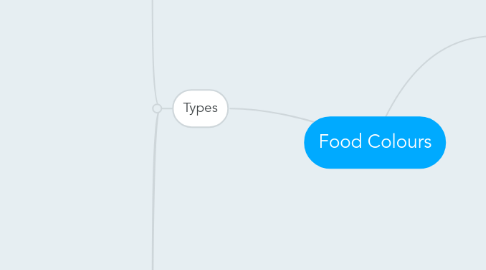
1. Types
1.1. Synthetic & natural
1.1.1. Synthetic (preferred) - smaller quantity (produce uniform, intense colour), stand up to heat, light, pH and do not add off-flavors
1.1.2. Natural colours- pigments derived from animal, vegetable and mineral sources
1.1.2.1. carotenoids (yellow to red)
1.1.2.2. anthocyanins (red, purple, blue)
1.1.2.3. caramel colour (light yellow to dark brown)
1.1.2.3.1. heating food-grade carbohydrate (corn syrup)
1.1.2.3.2. pH 2 - 10
1.1.2.3.3. Advantages
1.1.2.4. turmeric (yellow)
1.1.2.5. annatto (yellow to reddish orange)
1.1.2.6. carmine/ cochineal (pink, red, magenta)
1.1.2.7. Advantages
1.1.2.7.1. oil soluble - well suited for tinting high-fat, low-moisture food (can provide transparent colour to liquid, oil-based product.)
1.1.2.7.2. nutraceutical value (carotenoids & anthocyanins - antioxidants)
1.1.2.8. Disadvantages
1.1.2.8.1. Stability
1.1.2.8.2. Available colours
1.1.2.8.3. Concentration
1.1.2.8.4. Objectionable off flavors and off odours
1.1.2.8.5. Cost
1.1.3. Combining colours
1.1.3.1. Artificial blue + cabbage purple = bright purple shades
1.1.3.2. Carmine + yellowish caramel = green
1.1.3.3. Turmeric + artificial blue = neon green
1.2. Water soluble dyes & water insoluble lakes
1.2.1. Water-soluble dyes
1.2.1.1. comes in the form of powder, granule or liquid
1.2.1.2. used in aqueous beverages, dry mixes, confections, and dairy products
1.2.2. Lakes
1.2.2.1. water-soluble FD&C (base- aluminium hydroxide) combined with insoluble material/substrate
1.2.2.2. (Colours highlighted in green below) & 1 natural colour - carmine [0.05% - 0.30%]
1.2.2.3. Stable at pH 4.0 - 8.0
1.2.2.4. companies - dispersion form= liquid food grade carrier (sugar syrup/ glycerine/ propylene glycol)
1.2.2.5. Applications
1.2.2.5.1. Fat-based system (oil dispersion) - chocolates, compound coatings, icings & cookie fillings
1.2.2.5.2. Dispersion into the gum matrix provides homogenous coloration, despite limited amounts of water that would hinder colour development of a dye - chewing gum, coloured noodles
1.2.2.6. Advantages
1.2.2.6.1. Useful in dry mixes (snack seasoning) / cookie filling (if there is insufficient moisture to dissolve water-soluble colours)
1.2.2.6.2. Avoid colour migration (evenly dispersing colours)
1.2.2.6.3. Contributes opacity to enhance elegance of coated confections (more-even color coverage)
1.3. Primary colours approved by FDA
1.3.1. Blue No.1 = Brilliant Blue FCF
1.3.2. Blue No. 2 = Indigotine (royal blue)
1.3.3. Green No. 3 = Fast Green FCF (sea green) >Casing/surface of frankfurters and sausages
1.3.4. Red No.3 = Erythrosine (cherry red)
1.3.5. Red No. 40 = Allura Red AC (orange - red)
1.3.6. Yellow No.5 = Tartrazine (lemon yellow)
1.3.7. Yellow No.6 = Sunset yellow (orange)
